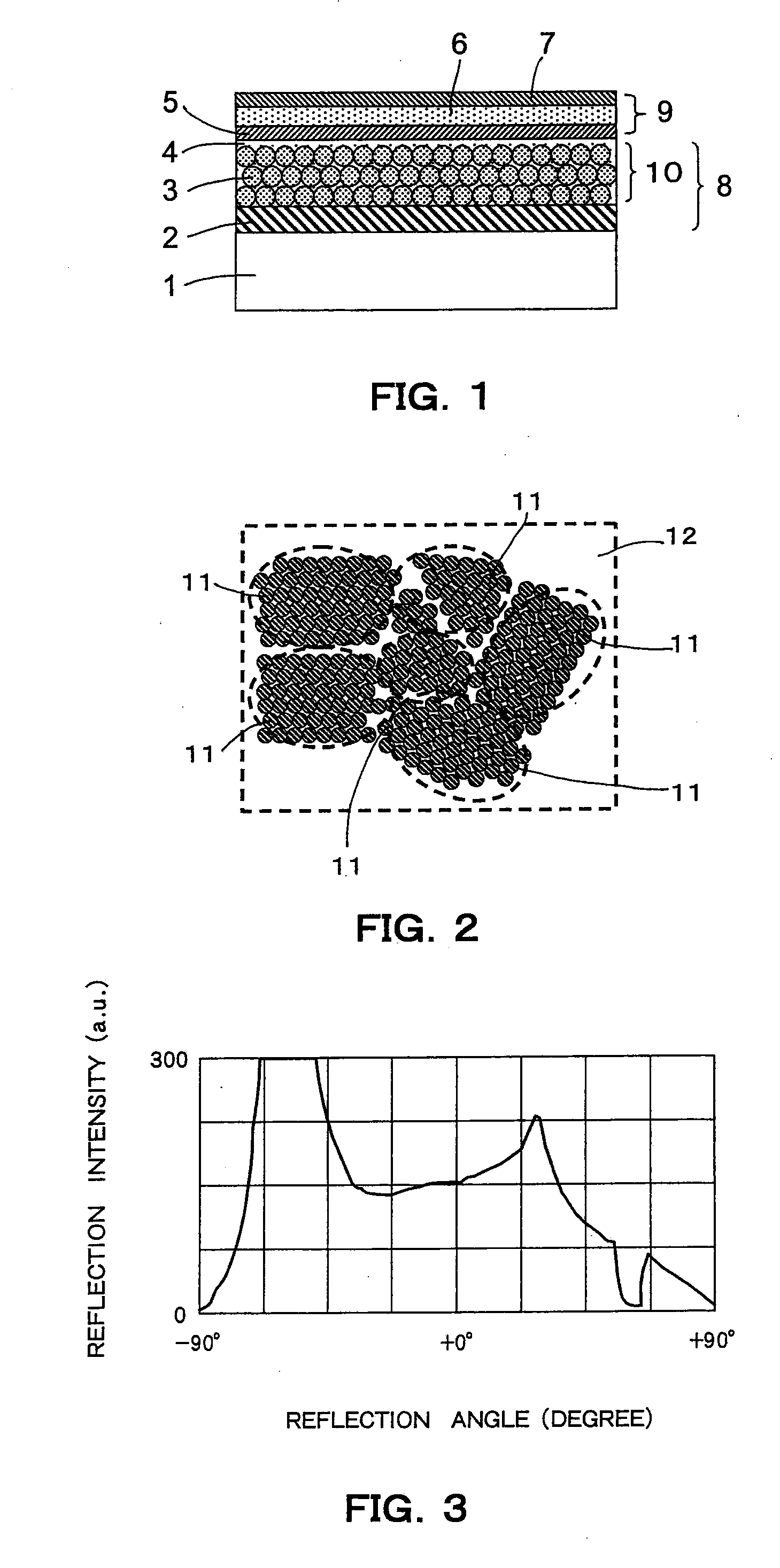Light-extraction layer of light-emitting device and organic electroluminescence element employing the same
- Summary
- Abstract
- Description
- Claims
- Application Information
AI Technical Summary
Benefits of technology
Problems solved by technology
Method used
Image
Examples
example 1
[0056]A glass substrate (refractive index: 1.48; TEMPAX Float [trademark], manufactured by Schott Nippon K.K.) as the substrate was prepared. After ITO was sputtered on the glass substrate to form a buffer layer of 10 nm thickness, silver was sputtered thereon to produce a reflecting layer of 200 nm thickness, and then ITO was sputtered again thereon to form a protective layer of 10 nm thickness. Independently, silica particles (mean particle size: 380 nm; CV value: 5%; n=1.42; PL-13 [trademark], manufactured by Fuso Chemical Co., Ltd.), which were beforehand surface-modified with a silane-coupling agent to have surfaces modified with acryl groups, were dispersed in three-functional acrylic monomer (ETPTA: ethoxylated trimethylolpropane triacrylate; n=1.47; manufactured by Aldrich Corp.) in the volume fraction of 60%. The prepared dispersion was spin-coated on the substrate at 2000 rpm, and then subjected to bake treatment on a hot-plate at 150° C. for 1 hour so as to thermally cure...
example 2
[0057]The procedures of Example 1 were repeated to form a three-dimensional diffraction layer on the substrate. Thereafter, the sample was immersed in 5% hydrofluoric acid aqueous solution for 5 minutes, and washed with flowing water for 15 minutes to remove only the silica particles accumulated in the layers. A section of the obtained sample was observed by SEM to confirm that only the particles were clearly removed and thereby that a three-dimensional diffraction layer comprises air bubbles as the fine particles and acrylic polymer as the matrix was produced (FIG. 7). In the same manner as in Example 1, a light-emitting layer was then formed on the three-dimensional diffraction layer. The sample was sealed with another glass substrate in nitrogen atomosphere, to obtain a top emitting type organic EL element.
example 3
[0058]The procedures of Example 1 were repeated except that the three-functional acrylic monomer was changed into trimethylol propane triacrylate (n=1.47; manufactured by Aldrich Corp.), to prepare a silica-dispersion, which was then spin-coated on the substrate at 2000 rpm. The sample was then subjected to bake treatment on a hot-plate at 150° C. for 1 hour, to evaporate the acrylic monomer. Thus, a three-dimensional diffraction layer comprised the silica particles and air as the matrix was produced. A section of the obtained sample was observed by FE-SEM to confirm that the particles were arranged like a crystal structure to form 15 layers (FIG. 8). This three-dimensional diffraction layer and the reflecting layer constituted a light-extraction layer according to the present invention. In the same manner as in Example 1, a light-emitting layer was then formed on the three-dimensional diffraction layer. The sample was sealed with another glass substrate in nitrogen atomosphere, to ...
PUM
 Login to View More
Login to View More Abstract
Description
Claims
Application Information
 Login to View More
Login to View More - R&D
- Intellectual Property
- Life Sciences
- Materials
- Tech Scout
- Unparalleled Data Quality
- Higher Quality Content
- 60% Fewer Hallucinations
Browse by: Latest US Patents, China's latest patents, Technical Efficacy Thesaurus, Application Domain, Technology Topic, Popular Technical Reports.
© 2025 PatSnap. All rights reserved.Legal|Privacy policy|Modern Slavery Act Transparency Statement|Sitemap|About US| Contact US: help@patsnap.com



